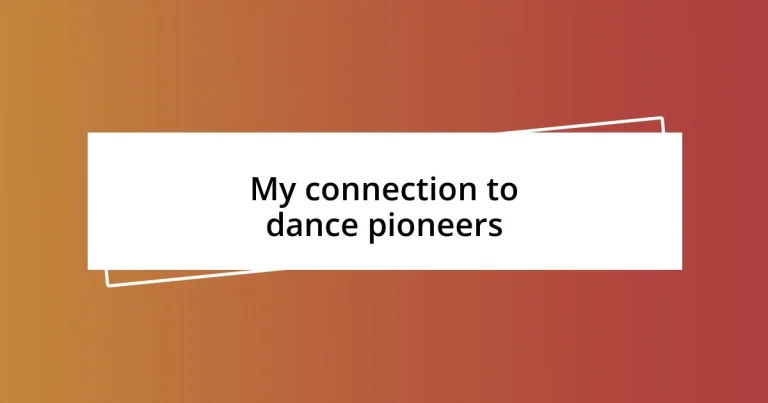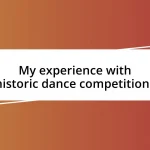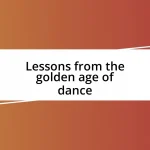Key takeaways:
- Dance pioneers like Martha Graham, Isadora Duncan, and Alvin Ailey revolutionized movement and expression, emphasizing the emotional connection and cultural identity in their art.
- Understanding the historical context of these pioneers allows for a deeper appreciation of their innovative approaches and the societal challenges they faced, influencing contemporary dance today.
- Personal experiences in dance reflect the lessons learned from these pioneers, emphasizing innovation, authenticity, and resilience as essential components of artistic growth and expression.
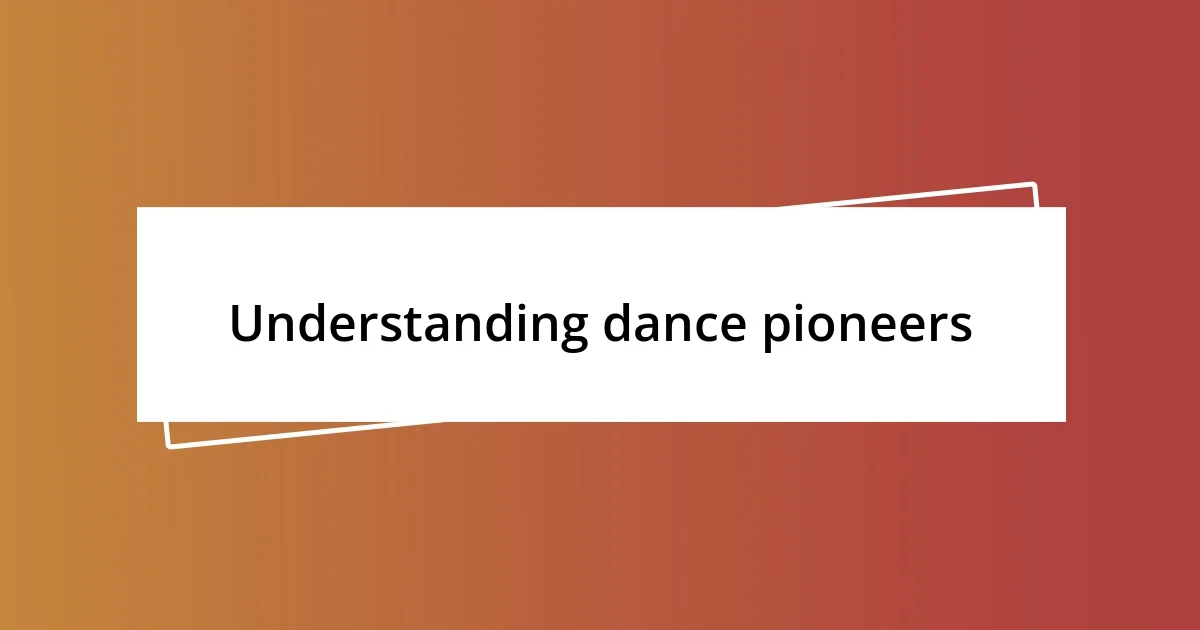
Understanding dance pioneers
Dance pioneers are the visionaries who reshaped the way we perceive movement and expression. I often find myself reflecting on how these figures, like Martha Graham and Alvin Ailey, didn’t just create dances; they instilled a sense of identity and culture into their art. How many times have you felt a stirring in your soul while watching a performance that transcended simple technique? That’s the magic that these pioneers cultivated.
It’s fascinating to think about the fearless risks they took to challenge societal norms. For instance, when I first learned about Isadora Duncan’s rejection of rigid ballet conventions, I felt a rush of inspiration; her pursuit of natural movement resonated deeply with my own journey in dance. I remember my first class where we were encouraged to explore our own interpretations of movement—an idea that, quite possibly, evolved from Duncan’s radical views.
Moreover, understanding dance pioneers is about connecting with their emotional journeys. Each choreographer faced struggles and triumphs that shaped their work—much like my own experience of battling self-doubt while performing. I often wonder: what unseen battles did they fight to share their artistry? Their legacies remind us that dance is not merely a series of steps, but an unfolding story that reflects our humanity.

Importance of historical context
Understanding the historical context of dance pioneers is crucial because it allows us to appreciate their innovative approaches within the frameworks of their times. When I think about the societal struggles that figures like Martha Graham faced, it deepens my understanding of her revolutionary choreography. For instance, her work wasn’t created in a vacuum; it was a courageous response to the constraints of her era, reflecting the cultural shifts happening around her.
Moreover, delving into the past reveals how each dancer’s or choreographer’s explorations were often a direct response to personal and societal challenges. I vividly remember a workshop where we were asked to recreate a piece inspired by Alvin Ailey. As I immersed myself in his themes of resilience and hope, I couldn’t help but feel how his life experiences permeated his art. This connection made the movements more than just steps; they transformed into a powerful narrative about overcoming adversity.
Recognizing the historical context not only enhances our appreciation of these artists but also challenges us to reflect on our own evolution in dance. I often ask myself how my own experiences shape the way I move and express myself. Just as these pioneers navigated their intricate lives through dance, I find myself channeling my emotions and stories into my own performances. This continuous dialogue between past and present enriches the dance community in ways I didn’t fully grasp until I truly appreciated the lives of those before me.
| Historical Context | Impact on Dance |
|---|---|
| Cultural Changes | Pioneers often responded to societal issues highlighting their relevance. |
| Personal Struggles | The difficulties faced by these pioneers shaped their artistic voice. |
| Evolution of Styles | Understanding their context reveals how styles emerged and adapted over time. |
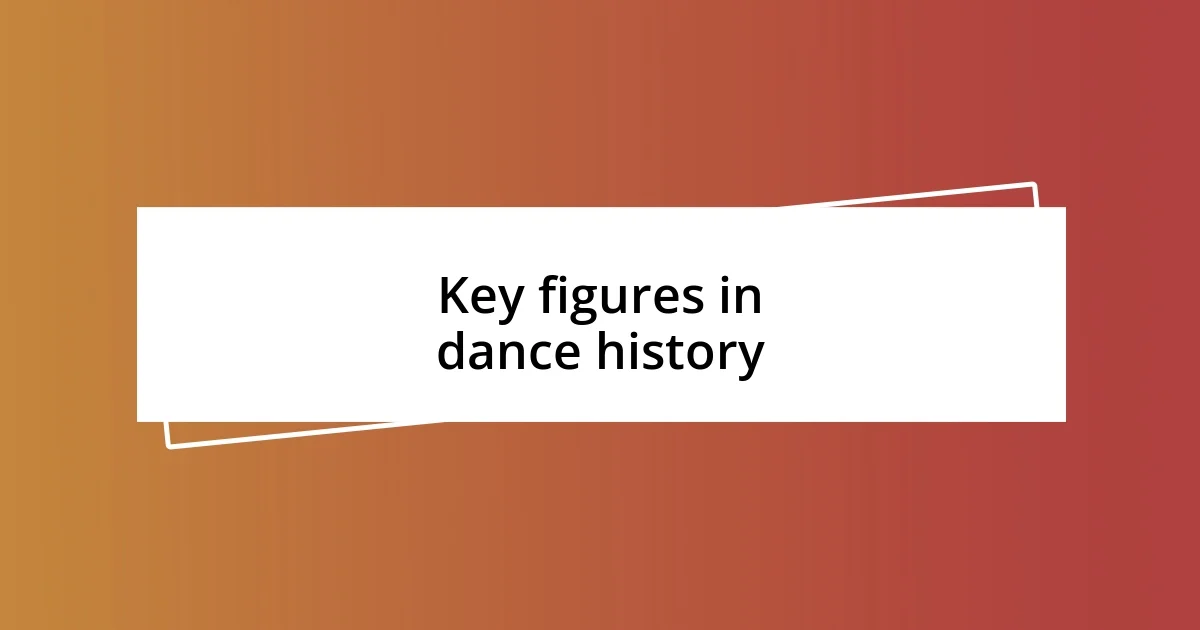
Key figures in dance history
Throughout dance history, several key figures have left an indelible mark on the art form. When I think about Martha Graham and her innovative approach, I feel a deep sense of admiration. Her emphasis on the body’s connection to emotion made me reconsider how I approach my own choreography; it’s not just about movement but about conveying feelings and experiences. Similarly, Alvin Ailey’s ability to weave narratives of African American life into his work resonates with me personally, reminding me of my own journey in blending cultural influences into my performances.
Here are some influential figures in dance history who bolded transformative movements and ideas:
- Martha Graham – The founder of modern dance; her technique emphasized emotional expression.
- Isadora Duncan – Often regarded as the mother of modern dance; she favored natural movement over ballet’s strict formality.
- Alvin Ailey – Pioneered a unique blend of modern dance and African American cultural themes, celebrated through the Ailey American Dance Theater.
- Pina Bausch – Known for her revolutionary work in Tanztheater, combining dance and theater to explore the human condition.
Each of these figures faced unique challenges that shaped their artistry. Reflecting on my own experiences in the dance studio, I often find parallel lessons within their stories. I remember a particular moment in a rehearsal when I experimented with a movement that embodied vulnerability—drawing inspiration from Bausch’s evocative style. It struck me then how these legends turned their personal trials into powerful visual narratives, prompting me to explore my own vulnerabilities in my dance journey. Their legacies of perseverance remind me that every stumble has the potential to create something beautiful.
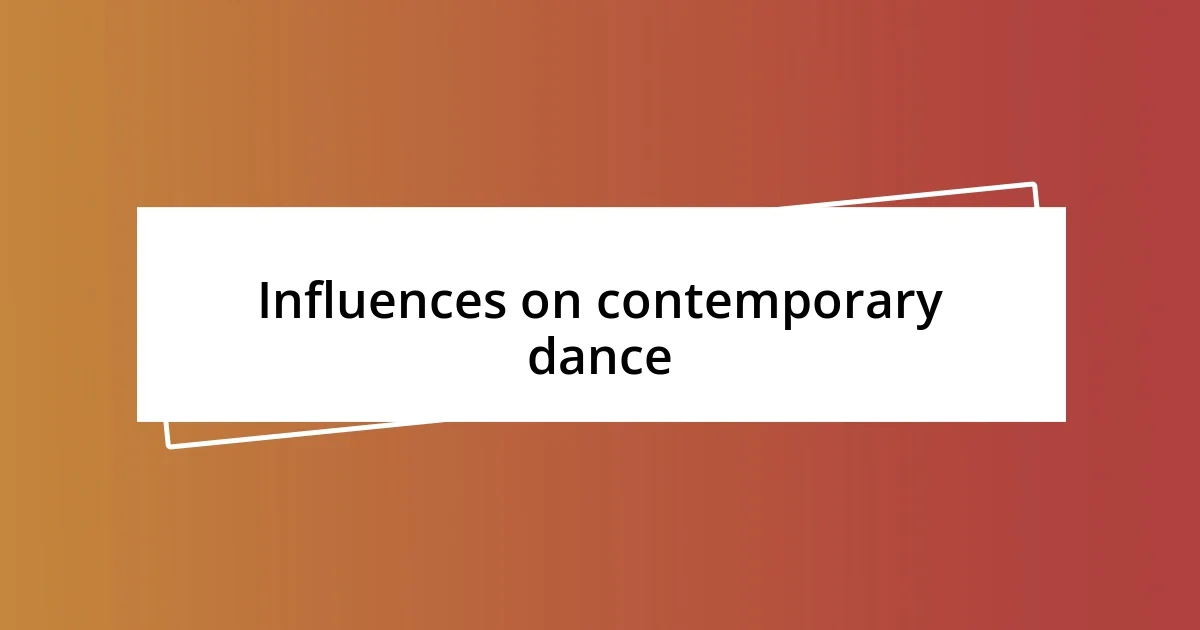
Influences on contemporary dance
Shifting my gaze towards the influences on contemporary dance, I can’t help but acknowledge the profound impact of cultural movements. For instance, the feminist movement inspired many contemporary choreographers to challenge traditional gender roles within dance. I once participated in a group project that focused on representing female strength through movement, a concept deeply rooted in the paradigm shifts initiated by trailblazers like Graham and Duncan. This exploration felt empowering; it opened my eyes to how choreography can serve as a platform for social commentary.
I’ve also noticed how the incorporation of technology in dance has transformed the landscape dramatically. When I attended a performance that utilized projection mapping alongside live choreography, I was mesmerized by how the visuals enhanced the storytelling. This fusion of art forms made me think: how does technology allow us to push the boundaries of traditional dance? The blending of different mediums, driven by creatives today, continues to redefine the viewer’s experience, showcasing that dance is not just a physical expression but a dynamic interplay of various artistic avenues.
Furthermore, exploring the diversity in movement vocabulary has been a crucial influence on contemporary dance. I often try to draw from various dance styles in my own work, infusing elements from hip-hop, ballet, and even traditional folk dances. I remember a workshop where we were encouraged to fuse styles to express our unique stories. The result was exhilarating; it made me realize how contemporary dance thrives on collaboration and cultural exchange. In this way, every dancer becomes a custodian of their lineage, weaving their heritage into the fabric of contemporary expression. It’s fascinating to realize that every move I make pays homage not only to those before me but also contributes to the ongoing evolution of this beautiful art form.
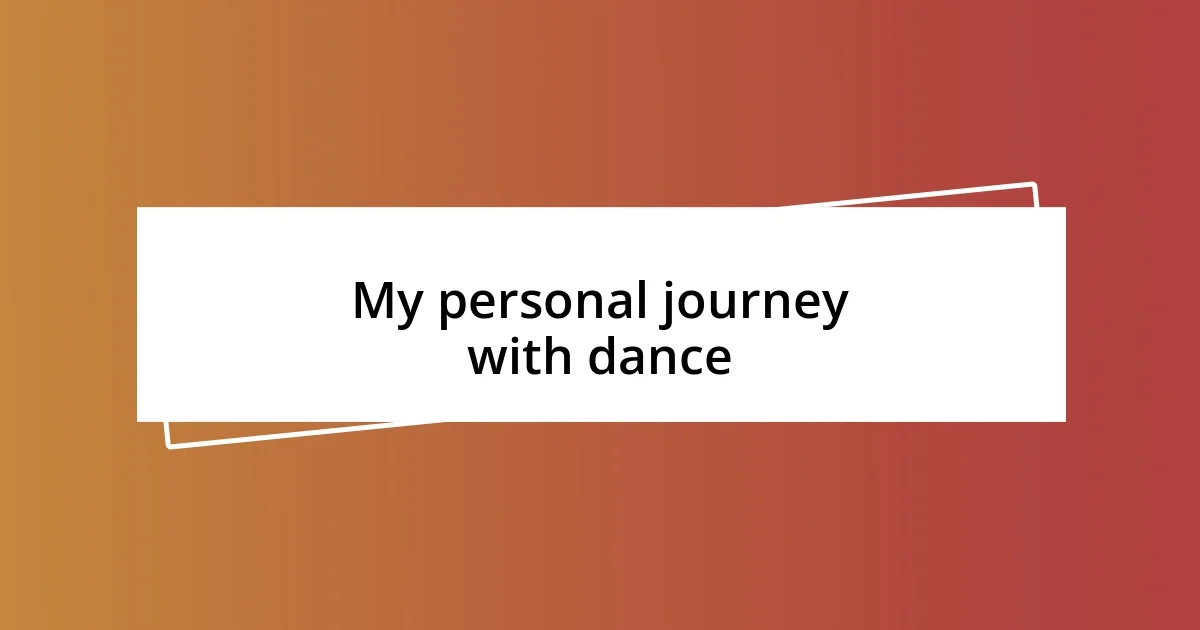
My personal journey with dance
When I first stepped into a dance studio as a shy teenager, I had no idea how profound this journey would be. My nervousness melted away during my first class when the instructor encouraged us to express ourselves freely. I felt a spark igniting within me, as if dance connected pieces of my identity I hadn’t yet discovered. This warmth grew as I immersed myself in different styles, each one revealing a new layer of myself.
As I honed my skills, I realized that dance was a mirror reflecting my experiences. There was a moment in a performance where I expressed heartbreak through movement; the audience responded with such empathy. It made me wonder: how could something so vulnerable resonate universally? I felt an emotional connection that transcended words, allowing me to share my story in a deeply intimate way. This exchange fueled my passion for exploring themes of life and love in my choreography.
Diving deeper into dance gave me a sense of community, too. I remember attending a workshop led by a talented artist who spoke about vulnerability in performance. It struck a chord with me; how often do we show our true selves on stage? In that moment, surrounded by fellow dancers from various backgrounds, I realized we were all on similar journeys. This bond strengthened my commitment to dance, inspiring me to incorporate diverse influences and stories into my work, creating a richer tapestry that reflects our shared humanity.
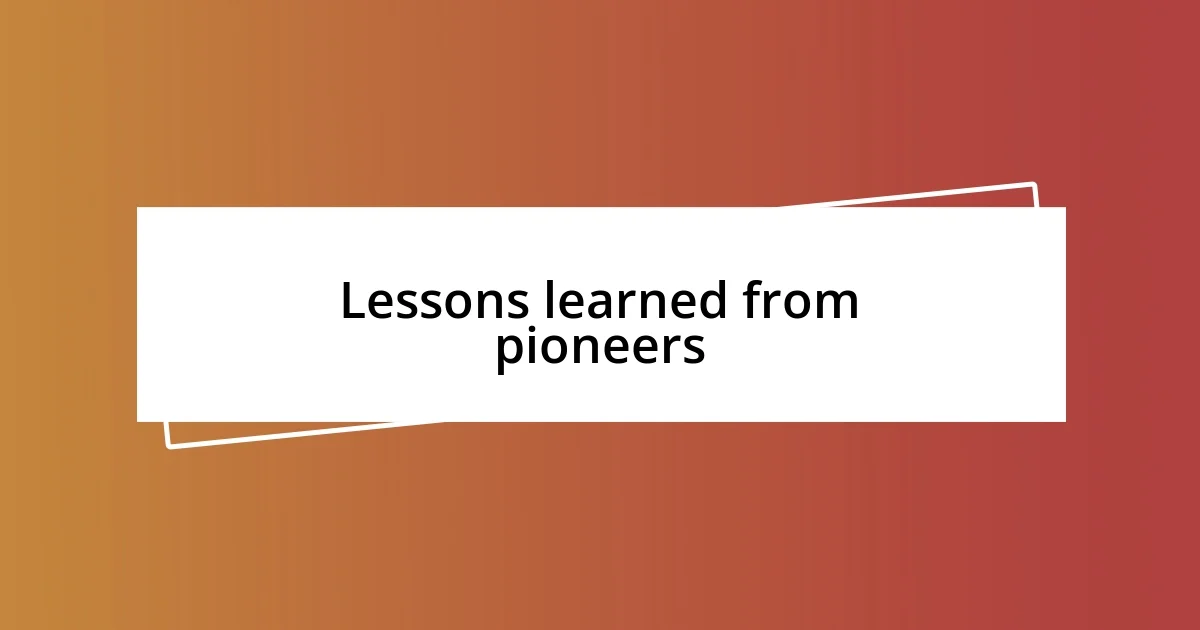
Lessons learned from pioneers
Lessons learned from pioneers can shape our understanding of dance profoundly. One crucial takeaway for me has been the importance of innovation. Watching the works of pioneers like Martha Graham, who pushed against the conventional norms, taught me that breaking boundaries can lead to remarkable discoveries. I remember the first time I experimented with unconventional movements in my choreography; it felt like stepping into unknown territory, but it ultimately allowed my voice to flourish in ways I never anticipated.
Moreover, the commitment of these pioneers to authenticity resonates deeply within me. For instance, when studying the work of Alvin Ailey, I found inspiration in how he celebrated cultural heritage and personal history. I once created a piece that drew on my own experiences, blending elements from my background and emotions. The feedback I received reaffirmed the idea that vulnerability can bridge gaps between performers and audiences, creating a shared narrative that speaks to the human experience.
Lastly, the resilience exhibited by these dance pioneers has taught me the value of perseverance. I often find myself reflecting on their journeys during challenging times. There were classes I thought I’d never master, moves I stumbled through, but each struggle was an opportunity to grow. This persistence inspired me when I faced setbacks; I learned to embrace them as part of my evolution as a dancer and choreographer, ultimately reminding me that every great artist has weathered their share of storms. How can we not honor their legacies by continuing to push forward in our own unique paths?












